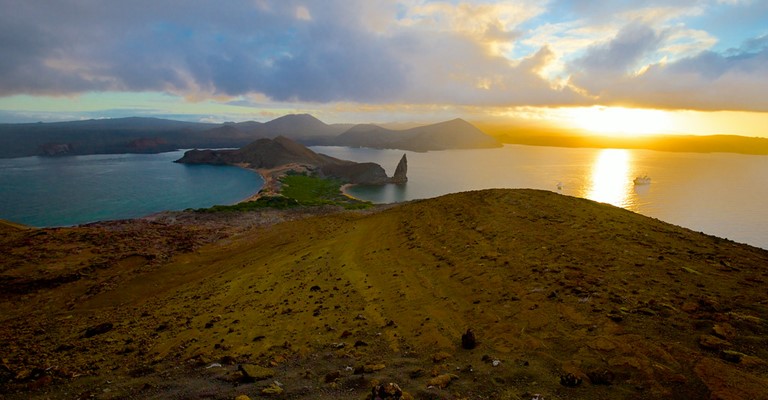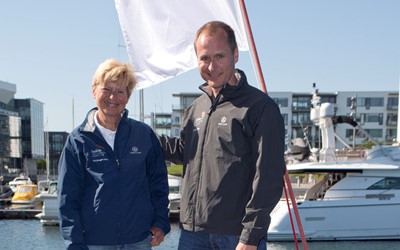
A Galapagos Affair - Courtesy of Josh Hall
Straddling the equator in the Pacific Ocean some 565 miles west of the South American mainland, the remote Galapagos Islands have a truly unique place in science, anthropology and history along with a most bizarre connection to MS.
The first ever visit of record to this archipelago was in 1535 by a Spanish Bishop en route to resolve a dispute in Peru, then part of the expansive Spanish Holy Empire. They were in fact lost, but the Galapagos became found and subsequently appeared on contemporary charts of the Pacific. Back in Madrid, the Bishop also reported the wealth of strange, beautiful and diverse vegetation and wildlife to his King and Church. In one of history’s more intriguing ironies these islands, discovered by a Bishop, would, 300 years hence, stimulate the question of evolution or creation that would rock a very religious world.
The first proper mapping and exploration of the islands was carried out by one of Britain’s far-flung pirates during 1684. Captain Ambrose Cowley took time out from his wayward ways to chart and name the area, blessing many bays and headlands with the illustrious names of his fellow pirates! The place-names became Spanish when Spain handed the islands over to Ecuador in 1832, though they remained unpopulated.
The island’s first official, and perhaps luckiest, inhabitant was an Irish sailor named Patrick Watkins who in 1807 was the sole survivor of a shipwreck. Watkins was stranded here for three years, no doubt developing a very un-Irish taste for turtle stew.
Having virtually destroyed the Atlantic whale population, the New England whaling fleet of the early 19th Century ventured ever further afield for their quarry, discovering and plundering eastern Pacific waters. Melville’s factually based novel of Moby Dick was written about an incident here during this era, as indeed was the remarkable true tale of lifeboat survival through cannibalism so eloquently written by Philbrick – In the Heart of the Sea, soon to be released as a movie (suggest eating before seeing the film!). During this period The Galapagos Islands served as a staging post for crews to replenish supplies and as a post box for homebound letters of commerce and love.
It was a period of adventure and discovery on a grand scale, serving a thirst for knowledge and a quest for answers to often un-known questions. A period when science began to seriously challenge centuries of indoctrinated beliefs and dogma – a period of brave scientists! Darwin’s voyage aboard HMS Beagle encapsulated the time. His theories on evolution, based on his discoveries and analysis of the extraordinary life in the Galapagos Islands were, and remain, ground-breaking and defining.
For an area so key to understanding our world, it is somewhat surprising that the islands and surrounding waters were only designated as protected in 1959. Any visiting yachts, such as Oceans of Hope, must adhere to strict measures including mandatory pre-arrival fumigation and hull-cleaning. The island’s biggest threats have always been from man arriving to bring imbalance to the fine equilibrium that exists here. During the 1990’s and 2000’s poverty-stricken Ecuadorian fishermen migrated here to make a better life for themselves. Years of violent disputes with the park authorities ensued, leading to the killing of many Giant Turtles and even the taking hostage of some officials. Trouble in paradise is a phrase that comes to mind.
The first proper settlers on the islands arrived in 1930 – a German Doctor named Friedrich Ritter and his girlfriend, Dore Strauch. Dore lived with MS. Seeking an isolated place to develop his holistic medical methods, they arrived having had all their teeth removed to avoid any dental issues. Their idyllic world did not last long as others followed in their wake, including the spectacularly named Eloisa von Wagner Bosquet. Eloisa was an Austrian Baroness who wore black leather boots, always carried a whip and brought with her three love slaves. The small community was soon at loggerheads with each other, the feud leading to the disappearance of some and the murder of others. Ritter died of food poisoning and Dore left the islands, but their bizarre story has been the subject of both book and film – The Galapagos Affair.
Our sailors are headed to the cradle of our planet’s species. They will witness some of nature’s true wonders and take steps in places many dream of visiting but very few have the opportunity to. They have hopefully finished their own food poisoning issues and they do not need to have their teeth removed as far as we know. What is sure is that they will leave no footprint – that, thankfully, is not permitted in these precious isles.
Many photo galleries can be found online. Here is one example of amazing photos by Peter Norvig.
http://pn.smugmug.com/keyword/galapagos/


